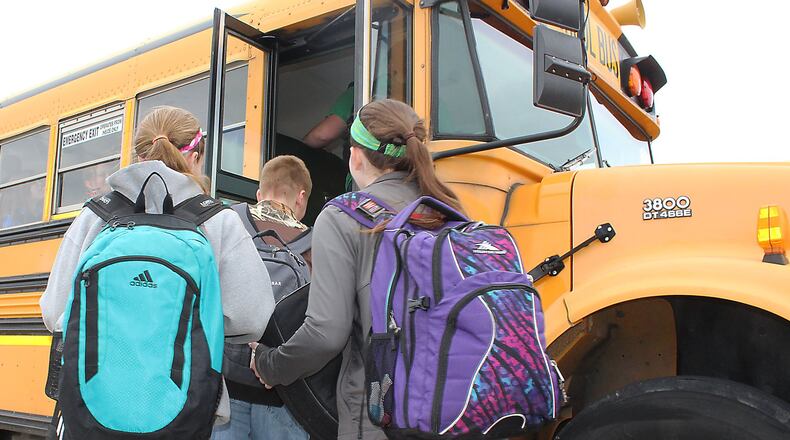Friends Ibrahim Ranginwala and Raaidh Rizvi started their project based on a health crisis that can be seen in the reflections of those of us who open those glass refrigerator doors.
“When I was thinking about the problem of obesity, in general, I thought of things that could fight it, said Ringinwala. A glance at the Food Pyramid and he said to himself “this is so confusing, no wonder it’s not working.”
Wondering what he would do “if we could just take it one step at a time,” he said, “I thought of sugary drinks. And this one simple phrase (Choose Water) could attack sugary drinks.”
He and Rizvi connected with Beth Dixon, an adult ally in Wellspring’s Bringing Awareness to Students (BAS) program, which encourages student-led health projects in the belief that peer messages might be more effective than mere messages.
“My job is sitting down with the kids and having them create a plan,” Dixon said. “What do you want to do, starting with the end in mind? If this is what you want, how can you get there?”
National data has established that Americans at large ingest 77 grams of sugar a day – more than three times the recommended 25 grams. The friends point out that a single serving of orange juice, for instance, has 33 grams of sugar, a regular Gatorade 34, both exceeding the minimum.
“And that,” says Rizvi, “leaves the rest of the day,” Rizvi said.
But the project’s first step was to establish that a problem really exists locally among their target group, students. That led the pair to survey students in Shawnee, Tecumseh and Springfield high schools and a junior high in each district – and at The Miami Valley School, which they attend.
The questions asked what students drank with their lunch that day and, on average, how many cans of soda they would drink in a day.
At Springfield High, for instance, 46.2 said they had less than one soda or sugary drink a day, a slight improvement over the 42.9 percent at Roosevelt Middle School. About one third of Roosevelt students and a fourth of Springfield High students said they had one or fewer cans of soda a day.
But the number who had two or more rose from 17 to 19 percent between middle school to high school and those who had three or more nearly doubled, from 5.7 percent to 11.5 percent.
At the private Miami Valley School, which the surveyors attend, 83.1 percent of the students drank only water, and 13.8 percent one soda a day. Ranginwala and Rizvi concluded that socio-economic factors play a role in drink selection.
With the data in hand, they’re now working with a teacher at Roosevelt Middle School on the “Choose Water Challenge” on TikTok. The plan is to give a prize to students who with the best video to promote water use among other students. The two also plan to sell T-Shirts with the Choose Water logo.
The information they’ve assembled into a Power Point presentation might provide the filmmakers with raw material.
“We really drive the health benefits,” said Rizvi, including benefits to the skin, pancreas and brain.
The brain is 70 percent water, the benefits of hydrated skin are well known, and the pancreas is the organ that helps maintain healthful blood sugar levels by producing insulin that balances sugar intake.
Sugar, Rizvi added “leaves bacteria on the teeth and is a burden on the heart when excising.”
“Even worse,” Ranginwala said, “when you try to find (substitutes) for sugar, you end up ingesting more salt and other non-organic substitutes.” All, said Rizvi, “are just as bad for you, if not worse.”
Because of the problems high salt and sugar levels cause for the kidneys, a nephrologist is supporting the Choose Water campaign.
Ringinwala and Rizvi are not blind to the temptation of sugary drinks and find the advice that people should drink eight 12-ounce glasses of water akin to an extreme sports challenge. They also admit to giving into temptation, though it now seems a choice.
Since starting the project, Ringinwala said, “it definitely is in my head, and I do think to choose water. It doesn’t always work.” Rizvi said he has “the same inclination,” but both “really spread the message through our cross country season,” and made progress within their team.
Along the way they also learned a lesson all leaders must learn: That their goal is not just to be passionate about an issue themselves but to make others feel just as passionate.
Another lesson likely is in store, one Dixon has been preparing them for.
In an initial presentation to the Springfield City Schools Board of Education, the two were warmly greeted, as expected. But they also plan to return to the board after a follow-up survey later in the year with a call for action.
“We want schools to give students an incentive to choose water over sugary (or diet) drinks,” said Ringinwala.
They will be able to argue that, in a cafeteria for hundreds of students, the sole drinking fountain at Springfield High is 60 steps away from the food line. But it’s also true that the school does offer water in bottles, next to sugary drinks in the high school lunch line, at the same cost.
However the quest for incentives turns out, the two friends will both have argued for their cause and learned a frustrating lesson all leaders must learn about the extent to which horses and people share a kinship: While we can be led to water, the trick will always be getting us to take that first drink.
About the Author
